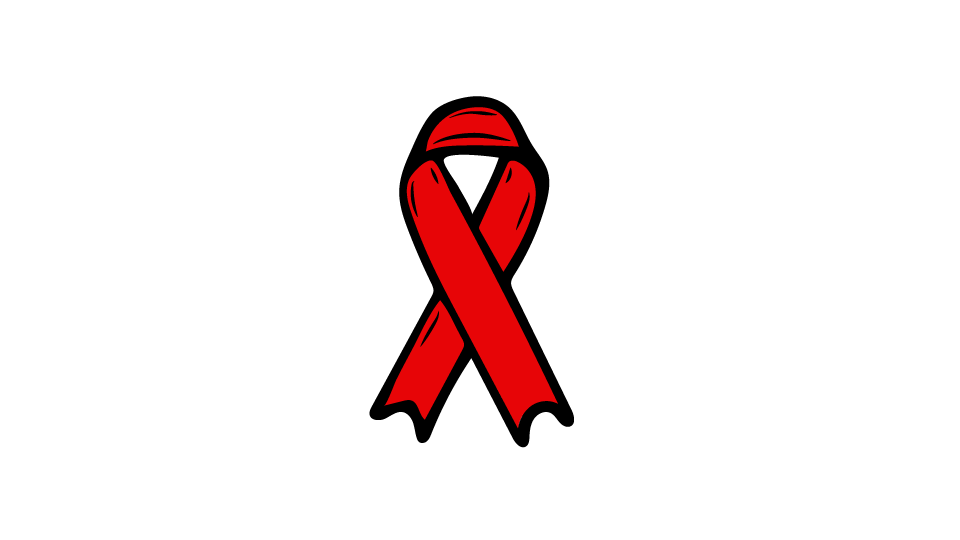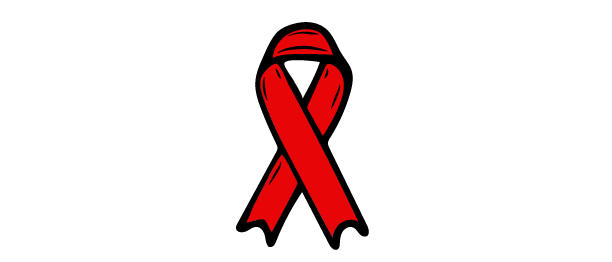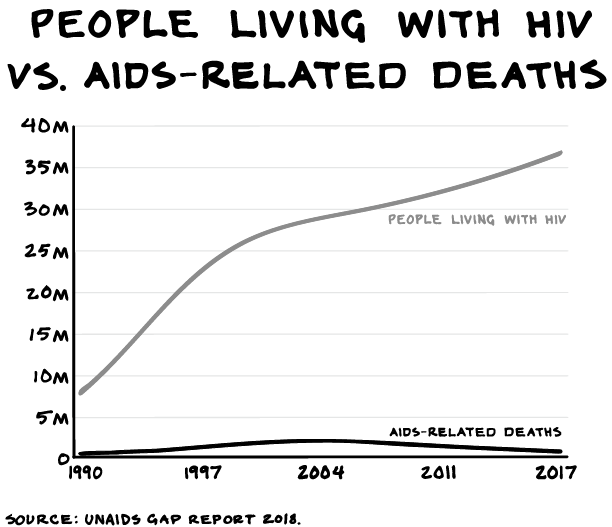
AIDS and Ghosts
I’ve been thinking about AIDS a lot lately. How’s that for an opening sentence?

I hope we’ll never see an epidemic this devastating again. One million people died from AIDS-related causes in 2017, and 36 million have succumbed to the disease since the beginning of the epidemic. In sum, the HIV virus has killed the population of Canada. AIDS-related deaths have been cut in half since their peak in 2004.
Just as we’ve outsourced war to young people who feel indebted to our country — unlike an increasingly large cohort who believe the country owes them — we outsourced and compartmentalized much of the suffering and the fight against AIDS. It was a “gay disease,” and we thought of a group who were victims as irresponsible instead. I believe our initial response to the crisis, as a nation, will go down as a stain on the American story.

In 1985, I remember sitting in the dining room of my fraternity and reading an LA Times article about scientists making progress toward an HIV vaccine. That meant this abstract thing called AIDS, that none of us had any contact with, was over. Only it wasn’t, and all of us would know several people who’d contract and ultimately die from an AIDS-related illness.
It was the perfect virus: it spread through sexual contact. Something all of us 18-year-old males were always thinking about and plotting. We were, theoretically, the agents and warriors for the virus. We took cold comfort believing AIDS was a disease only gay men got. And none of us knew anybody who was gay.
But we did. A bunch of us were gay. Only most, if not all, of the heterosexuals in our circle had no idea. Anybody you liked who seemed “normal” couldn’t be gay, as that was a strange perversion. Definitely not anybody we knew. You couldn’t be openly gay at UCLA in the eighties. It didn’t matter how brave or comfortable with yourself you were. Being gay was unnatural. We were young men and women at UCLA, which was a postcard for natural and wholesome, and there was no tolerance for fucking with the postcard.
Yet this was slowly becoming the era when being gay was tolerated. Not accepted, but tolerated. Several friends let it be known they were gay post-graduation. AIDS haunted all of them, always around, waiting, striking. Not as menacing, but still there. AIDS haunted everyone, as years earlier the blood supply had been tainted, and there was evidence this wasn’t just a “gay disease.” Straight people could also contract HIV. Unprotected sex meant several days of anxiety leading to 100% certainty you had the virus.
Some of our friends from UCLA who contracted HIV:
— Bill Aarons: a Lambda Chi. Quiet, handsome kid who, we found out later, was a hemophiliac.
— Ron Baham: our UCLA fraternity brother. A preppy black kid with a movie star voice.
— Pat Jarvis: my UCLA freshman roommate from Visalia. Pat grew up on a farm and came to UCLA to study theater. He was always chewing tobacco. He’d always borrow/steal my clothes, which was ok, as we both borrowed/stole from our other roommate Gary.
— Tom Bailey: my best friend Jim’s partner. A handsome guy from Atlanta who was a creative director at an ad agency that Jim fell very much in love with.
I’ve been introduced to Kahneman’s notion of fast and slow thinking, that our fast, shorthand thinking offers utility but a lack of nuance. Slow thinking is where we grow and learn; it informs the fast … I think. College was for fast thinking. Homosexuals were fags, and “gay” was a slur to describe something weak and unnatural. The decade after college was for slow thinking as we discovered people we loved were gay. They had similar hopes and problems as us, only they were stalked by a plague, and their friends were dying.
After I sold my first e-commerce firm, Aardvark, we moved from a two-bedroom in Potrero Hill to a five-bedroom in Noe Valley. The home is next to where Mark Zuckerberg now lives. I hate myself for selling it, as 1) it’s likely worth $10M or more; and 2) I’d register enormous joy sitting on my porch in a Fila tracksuit and yelling at Zuck, “How does it feel to be Putin’s bitch?” But I digress. My then-wife and I would go to the Castro to shop for furniture to fill the five bedrooms and would see ghosts everywhere. Men in their thirties and forties who were painfully thin and had sores littering their persons. Thirty-five-year-old men who looked 80, barreling toward death. Ghosts, everywhere.
We’d like to think the time leading up to death is a period when you can reflect on a long life of blessings. It’s a time to register the love you’ve invested and harvested. These young men were being taken early by a virus ravaging their bodies. Their backdrop: a society that had decided they weren’t really victims. Not long before, we’d had a president, Reagan, who never uttered the word “AIDS” in his eight years in the White House.
Bill Aarons was the first to die. Bill contracted the virus from the treatment that had liberated him from the tyranny of his blood disorder: clotting factors made from donated blood. Approximately half of the nation’s 15,000 hemophiliacs were infected. Bill died at 26.
Ron became a talent agent for CAA and rose to be Director of Current TV at Disney by the age of 30. I saw Ron a decade after graduation at a friend’s wedding, and it was apparent his HIV had become full-blown AIDS. A few months later, Ron called several people he felt he needed to make amends with, mixed the contents of two dozen Valium capsules into a glass of vodka, and ingested the cocktail. Ron was dead at 33.
Pat struggled with his sexuality and would attend re-education camps hosted by religious groups who felt homosexuality was learned, and that one could be deprogrammed. Pat, someone we should have all continued to be good friends with, as we were in college, just faded away. One of our group, a successful dentist, filled a cavity for Pat, who was in rough shape. Pat claimed he was suffering from a bad case of Lyme disease. Suffering, but still not trusting or wanting our friendship and love, as he’d seen the fast thinking at UCLA. I heard Pat died about a decade ago, but none of us are sure exactly when or where. I’m embarrassed and ashamed I didn’t have the decency to track him down and tell him how impressive a person I thought he was, and that I was thinking about him. I am so sorry, Pat.
Tom Bailey was caught by the warm grasp of the hand of science and has been on antiretroviral treatment for 20 years. In addition to a successful career in advertising, Tom opened a spin studio, where he was an instructor. He is the godfather to my oldest son. He’s a lousy godparent. But he’s healthy and married my best friend. And that’s enough.
Life is so rich,

0 Comments
Need more Scott in your life?
The Prof G Markets Pod now has a newsletter edition. Sign up here to receive it every Monday. What a thrill.

